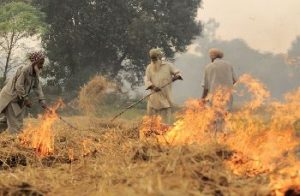 The claims of Punjab and Haryana pertaining to their efforts to check the problem of stubble burning notwithstanding, the menace has not only persisted but has aggravated severely this paddy harvesting season.
The claims of Punjab and Haryana pertaining to their efforts to check the problem of stubble burning notwithstanding, the menace has not only persisted but has aggravated severely this paddy harvesting season.
This yearly phenomenon of farm fires gravely precipitates the air pollution in national capital Delhi in particular, triggering a blame game among political bigwigs of the adjoining food bowl states and the other stake-holders.
By the last week of October, the number of stubble burning cases in Punjab had crossed the 10,000 mark and in Haryana, over 3,300; the numbers are double the figure for the corresponding period last year in the two states.
Both the states, however, have their respective sets of claims and efforts with a special focus on the awareness drives to check the menace, as the burning of farm residues gravely damages the environment and the soil quality.
The Punjab Pollution Control Board (PPCB) member secretary Krunesh Garg highlights the Punjab government multi-pronged methods as well as subsidy given to farmers on the machinery to handle in-situ and ex-situ stubble management.
He says the state government workforce has been working hard to check the menace through various steps and awareness campaigns. A large number of farmers have been using machinery for in-situ an ex-situ management while the ones who still burnt the farm residues are booked and fined for environmental compensation, he says adding that so far cases against 1,500 farmers had been registered with 40 lakh fine.
The situation in Haryana is no different. S Narayanan, member secretary, Haryana State Pollution Control Board said the rise in farm fires was because of early harvesting. He also highlights awareness drives and says that advisories to district administrations had also been sent to take action against offenders.
According to information, more than 3,300 cases had been registered in the state till the last week of October, besides 159 police cases and fine worth 15 lakh. The cases showed a 44 % rise in the farm fires this year, despite the distribution of about 13,236 machines on subsidies.
The agriculture department officials, who did not want to be named, however, agreed that a whopping amount of 1,300 crore had been spent on providing subsidised machines to farmers for the management of the crop waste though incidence of stubble burning in the state was still on the rise.
Why a spurt?
The menace has not only been unabated, its incidence has doubled primarily in Punjab and Haryana reportedly because of the reluctance of the official agencies to act against the offending farmers who are already angry and continuing a major showdown against the government over the recently passed three farm legislations.
The officials of the agriculture departments of Punjab and Haryana admit on the condition of anonymity that the stubble burning started at the time farmer unions were already protesting, blocking national highways and railway tracks and booking them for farm fires could have aggravated the situation.
Politically too, it suits the Congress government in Punjab to side with farmers against the new legislations passed by BJP-led national democratic alliance (NDA) government at the Centre.
The officials also cite an early paddy harvest season this year in the two states — from around September 18 and procurement from September 26 — as one of the reasons behind the rise in the number of farm fire cases.
Also, the stakeholders also allege that since most of the machines purchased by the customer hiring centres fail to small farmers — 80 % of the total farmers’ population in the two state — the menace of burning farm residues, persists. Only the big farmers get benefit of the subsidised machines, the officials of Haryana agriculture department said.
The small farmers thus intend to clear their fields quickly to grow vegetables which fetch a good price in retail markets.
From the farmers’ standpoint, the paddy straw is burnt in the field itself as the farmers want to get rid of it without any delay to sow wheat or other crops as early as possible by mid-November. The farmers’ organisations also cite financial issue behind managing stubble instead of burning it which costs zilch. The burning of these farm residues, nonetheless, gravely affects the environment, besides the soil, in the long run.
Trouble may grow
Another significant aspect behind the rise in farm fire cases which the government officials may not like to highlight is a steady increase in the area under the Parmal varieties. Farmers say that since Parmal varieties are harvested by the combine harvesters, stubble management remains a difficult task.
 According to them, since the prices of Basmati varieties have declined drastically this year, there is a strong possibility of further rise of area under the Parmal vairities as they are being sold on MSP and fetching around 20,000 more per acre more. While there is an average of 20 quintal Basmati variety an acre yield, the same is 30 quintal, an acre of Parmal variety.
According to them, since the prices of Basmati varieties have declined drastically this year, there is a strong possibility of further rise of area under the Parmal vairities as they are being sold on MSP and fetching around 20,000 more per acre more. While there is an average of 20 quintal Basmati variety an acre yield, the same is 30 quintal, an acre of Parmal variety.
Farmers thus burn paddy stubble to quickly clear the fields for sowing of winter wheat crop which is procured by the government to sustain the Public Distribution System (PDS).
Delhi suffocates
However, there is a hue and cry every paddy season as the air pollution situation aggravates in Delhi with the north easterly winds bringing the pollutants from farm fires in the two states, which mix with menacing local industrial, vehicular and domestic emissions causing a spike in pollution levels in the National Capital Region and Delhi in particular.
Air pollution scientists observe that there is a spurt in the local emissions as the stubble burning results in an increase in pollution levels in the region. Delhi, besides a few adjoining cities like Gurugram, Faridabad and Rohtak have reported poor to very poor air quality in October.
And it is in this context that the bordering national capital Delhi raises the red flag after the pollutants suffocates it to the hilt. It is also feared that the deteriorating air quality could aggravate the Covid-19 pandemic in the region.
Delhi chief minister Arvind Kejriwal has thus also urged upon the Union environment minister Prakash Javadekar to hold monthly meetings with the chief ministers of Delhi, Punjab, Haryana and Uttar Pradesh to check the air pollution and said that there was a lack of political will at the level of states to address the issue.
The Punjab chief minister Captain Amarinder Singh on the other hand has claimed that Delhi’s air pollution problem was primarily because of local factors. The top officials of Punjab and Haryana pollution control boards have also maintained that it is the local factors which caused pollution problem in Delhi, while the farm fires contributed only 5 % to 10 % to it.
The game-changer
Meanwhile, Kejriwal’s announcement that the Delhi government would provide capsules to city’s farmers that could be used to decompose stubble so it did not have to be burnt, seems to hold a promise to be game-changer.
According to information, a bio-decomposer technique developed by the Indian agriculture research institute (IARI) at Delhi’s PUSA institute, called Pusa decomposer involves making a liquid formulation using Pusa decomposer capsules and readily available inputs, fermenting it over eight to 10 days and then spraying the mixture on the fields with stubble to ensure speedy bio-decomposition of the stubble.
Meanwhile, the number of progressive farmers and entrepreneurs in the two states who are making a lucrative income by managing stubble, is also on the rise.
Sample this: Hans Raj Garg, a Fatehgarh Sahib (Punjab)-based entrepreneur has been buying stubble from farmers of nearby 35,000 acres and using its bales as a fuel to generate power for his vegetable oil refining mill. “We have been using it and generating 3 MW power an hour and found it to be profitable’’, he says.
letters@tehelka.com













